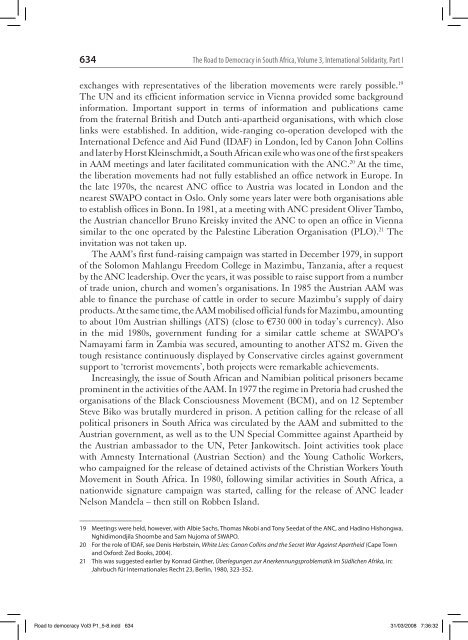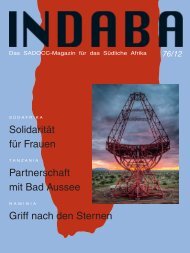Austria and South Africa during apartheid The set-up of ... - SADOCC
Austria and South Africa during apartheid The set-up of ... - SADOCC
Austria and South Africa during apartheid The set-up of ... - SADOCC
You also want an ePaper? Increase the reach of your titles
YUMPU automatically turns print PDFs into web optimized ePapers that Google loves.
634 <strong>The</strong> Road to Democracy in <strong>South</strong> <strong>Africa</strong>, Volume 3, International Solidarity, Part I<br />
exchanges with representatives <strong>of</strong> the liberation movements were rarely possible. 19<br />
<strong>The</strong> UN <strong>and</strong> its efficient information service in Vienna provided some background<br />
information. Important s<strong>up</strong>port in terms <strong>of</strong> information <strong>and</strong> publications came<br />
from the fraternal British <strong>and</strong> Dutch anti-<strong>apartheid</strong> organisations, with which close<br />
links were established. In addition, wide-ranging co-operation developed with the<br />
International Defence <strong>and</strong> Aid Fund (IDAF) in London, led by Canon John Collins<br />
<strong>and</strong> later by Horst Kleinschmidt, a <strong>South</strong> <strong>Africa</strong>n exile who was one <strong>of</strong> the first speakers<br />
in AAM meetings <strong>and</strong> later facilitated communication with the ANC. 20 At the time,<br />
the liberation movements had not fully established an <strong>of</strong>fice network in Europe. In<br />
the late 1970s, the nearest ANC <strong>of</strong>fice to <strong>Austria</strong> was located in London <strong>and</strong> the<br />
nearest SWAPO contact in Oslo. Only some years later were both organisations able<br />
to establish <strong>of</strong>fices in Bonn. In 1981, at a meeting with ANC president Oliver Tambo,<br />
the <strong>Austria</strong>n chancellor Bruno Kreisky invited the ANC to open an <strong>of</strong>fice in Vienna<br />
similar to the one operated by the Palestine Liberation Organisation (PLO). 21 <strong>The</strong><br />
invitation was not taken <strong>up</strong>.<br />
<strong>The</strong> AAM’s first fund-raising campaign was started in December 1979, in s<strong>up</strong>port<br />
<strong>of</strong> the Solomon Mahlangu Freedom College in Mazimbu, Tanzania, after a request<br />
by the ANC leadership. Over the years, it was possible to raise s<strong>up</strong>port from a number<br />
<strong>of</strong> trade union, church <strong>and</strong> women’s organisations. In 1985 the <strong>Austria</strong>n AAM was<br />
able to finance the purchase <strong>of</strong> cattle in order to secure Mazimbu’s s<strong>up</strong>ply <strong>of</strong> dairy<br />
products. At the same time, the AAM mobilised <strong>of</strong>ficial funds for Mazimbu, amounting<br />
to about 10m <strong>Austria</strong>n shillings (ATS) (close to €730 000 in today’s currency). Also<br />
in the mid 1980s, government funding for a similar cattle scheme at SWAPO’s<br />
Namayami farm in Zambia was secured, amounting to another ATS2 m. Given the<br />
tough resistance continuously displayed by Conservative circles against government<br />
s<strong>up</strong>port to ‘terrorist movements’, both projects were remarkable achievements.<br />
Increasingly, the issue <strong>of</strong> <strong>South</strong> <strong>Africa</strong>n <strong>and</strong> Namibian political prisoners became<br />
prominent in the activities <strong>of</strong> the AAM. In 1977 the regime in Pretoria had crushed the<br />
organisations <strong>of</strong> the Black Consciousness Movement (BCM), <strong>and</strong> on 12 September<br />
Steve Biko was brutally murdered in prison. A petition calling for the release <strong>of</strong> all<br />
political prisoners in <strong>South</strong> <strong>Africa</strong> was circulated by the AAM <strong>and</strong> submitted to the<br />
<strong>Austria</strong>n government, as well as to the UN Special Committee against Apartheid by<br />
the <strong>Austria</strong>n ambassador to the UN, Peter Jankowitsch. Joint activities took place<br />
with Amnesty International (<strong>Austria</strong>n Section) <strong>and</strong> the Young Catholic Workers,<br />
who campaigned for the release <strong>of</strong> detained activists <strong>of</strong> the Christian Workers Youth<br />
Movement in <strong>South</strong> <strong>Africa</strong>. In 1980, following similar activities in <strong>South</strong> <strong>Africa</strong>, a<br />
nationwide signature campaign was started, calling for the release <strong>of</strong> ANC leader<br />
Nelson M<strong>and</strong>ela – then still on Robben Isl<strong>and</strong>.<br />
19 Meetings were held, however, with Albie Sachs, Thomas Nkobi <strong>and</strong> Tony Seedat <strong>of</strong> the ANC, <strong>and</strong> Hadino Hishongwa,<br />
Nghidimondjila Shoombe <strong>and</strong> Sam Nujoma <strong>of</strong> SWAPO.<br />
20 For the role <strong>of</strong> IDAF, see Denis Herbstein, White Lies: Canon Collins <strong>and</strong> the Secret War Against Apartheid (Cape Town<br />
<strong>and</strong> Oxford: Zed Books, 2004).<br />
21 This was suggested earlier by Konrad Ginther, Überlegungen zur Anerkennungsproblematik im Südlichen Afrika, in:<br />
Jahrbuch für Internationales Recht 23, Berlin, 1980, 323-352.<br />
Road to democracy Vol3 P1_5-8.indd 634 31/03/2008 7:36:32





